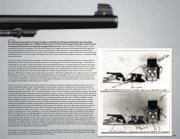Page 465 - 4094-BOOK2
P. 465
463
LOT 1540
Rare, Well-Documented, Historic Famed Handgunner Ed McGivern’s Montana Shipped Early Speed Shooting
Record Setting Smith & Wesson .38 Military & Police Model of 1905 Fourth Change Double Action Target Revolver
as Featured in Fast and Fancy Revolver Shooting with Factory Letter - Serial no. 286600, 38 S&W special cal., 6 inch
round bbl., blue finish, walnut grips. This S&W .38 Military & Police target revolver has an intriguing, historically significant
past. Originally shipped to the famed Anaconda Copper Mining Co. of Montana, this revolver ended up in the hands of
legendary handgunner Ed McGivern. As noted by the two gold inscription plaques mounted on the frame, the revolver was
used by McGivern to set his early speed shooting records. This revolver also has impeccable provenance as outlined by S&W
historian Roy Jinks.
The history of this revolver and its ownership is found in two letters written by S&W historian Roy Jinks. Confirmed by the
S&W factory records, the factory letter indicates the revolver was shipped to Anaconda Copper Mining Co. of Montana, on
September 26, 1917 with a 6 inch barrel, Marble Sheard front sight, blue finish, and checkered gold medallion walnut grips.
In the factory letter Jinks stated that McGivern used the revolver to set his early speed shooting records, and these record
times are immortalized on two gold plates mounted on the frame. In an included letter to previous revolver owner Colonel
Rex Applegate, Jinks presented further details. S&W Vice President Douglas B. Wesson later obtained the revolver from
McGivern. After Wesson’s death, Jinks purchased this revolver from the Wesson family. Jinks later sold the revolver to Colonel
Rex Applegate and then in 1999 it was purchased by Mike Priwer. Jinks concluded, “There is no question of the importance
of the revolver as it helped to illustrate that Smith & Wesson revolvers were the finest double actions in the world. It was
used in many Smith & Wesson advertisements and Doug Wesson displayed it to many police officers to impress them with
the quality of Smith & Wesson’s Double Action revolvers.”
Jinks, however, is incorrect about the details related to how McGivern and later Doug Wesson obtained the revolver. The
correct story is presented in copies of included letters written between Wesson and McGivern. In these letters we learn
that McGivern used the .38 M&P no. 286600 as partial payment for a brand new, extremely early production 6 ½ inch .357
Registered Magnum (Reg. No. 8). This is clearly illustrated in a July 30, 1935 letter Wesson wrote McGivern: “You’re absolutely
correct in thinking that the Magnum was not to be billed to you as, of course, it is part payment for the .38 Military & Police
that did the original high speed work.” Copies of McGivern’s S&W order for Reg. No. 8 are included. Talk of a gun trade dated
back to at least 1930 when Wesson wrote McGivern: “I certainly appreciate your offer of your 38 ‘Record Maker’ together
with this affidavit, but just at the present time I wouldn’t take advantage of it. When I do, we certainly can fix up a trade
for the revolvers that you need to fill out your list. I will be particularly interested in doing this not only for the reason of
showing my appreciation for what you have done for Smith & Wesson in the past, but also to have the chance to refute
the impression that some people have that this present output of the plant is not quite equal to that in the past, whereas,
actually I know that our inspection is closer and our manufacturing nicer than it has ever been.” Wesson’s letter was in
response to McGivern’s letter of October 28, 1930. It would be a few years later before talk of an exchange was brought up
again. In a September 19, 1933 letter Wesson calls out the .38 M&P by serial number: “If you have definitely decided that
you are through with your old .38 M.&P #286600 I am very anxious indeed to get it, together with a statement from you
as to its performances, because it will make a wonderful exhibit as the fastest shooting gun, or rather, the gun that has
been shot faster than any other in the world, and I can use it to great advantage in my work...” A few days prior to Wesson’s
September 1933 letter, McGivern called for a trade as well as confirmed how he obtained no. 286600. McGivern wrote, “I
mentioned some time ago that I would be willing to let you have the gun with the gold plates on, for your own museum or
relic collection, or for that of the company, in exchange for which I wanted some guns for my own use, as this gun belonged
originally to Mr. L.A. Smith when he was deputy sheriff…”
The revolver is pictured and identified in McGivern’s “Fast and Fancy Revolver Shooting” on page 140. In one of the images
the revolver is connected to a timing device used by McGivern. The elaborate timing device was of McGivern’s own design
and provided measurements in increments down to 1/20 second.


